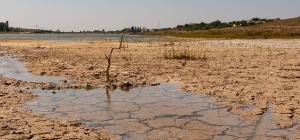
Mosquitoes in a changing climate

Mosquitoes are vectors of numerous diseases worldwide. However, only certain species of mosquito can carry diseases, and even fewer of these species can survive Canada’s harsh winters. Of Canada’s approximately 80 known mosquito species, only a small proportion carry disease, the most common of which is West Nile Virus (WNV). Human cases of WNV have been reported across Canada, with the exception of Newfoundland and the Territories. Other endemic diseases such as Eastern equine encephalitis (EEEV), Jamestown Canyon virus (JCV) and snowshoe hare virus (SSHV) have been reported in small numbers. While EEV cases have so far been confirmed only in Ontario, both JCV and SSHV are more widely distributed across Canada, including in the Territories. While there have been a number of cases of Zika virus detected in travellers returning to Canada from abroad, only one of the two species that transmits Zika virus, Aedes albopictus, has become established in Canada. So far, this established population remains small and in a very limited part of Southwestern Ontario.
Mosquito-borne viruses are maintained in nature in a cycle between female mosquitoes and specific animal hosts. Mosquitoes can then transmit the virus to humans and other mammals like horses, which are considered dead-end hosts as they are unable to transmit the virus further due to an insufficient presence of the virus in their blood.
Disease transmission pathway for WNV, EEE, JCV, and SSHV

Only certain mosquito species play a role in the disease transmission cycle. Predominant mosquito vectors for each disease include:
- WNV: Culex spp.
- EEE: Aedes vexans, Coquillettidia perturbans, Culiseta melanura
- JCV: Aedes spp., Culiseta spp., Anopheles spp.
- SSHV: Aedes spp., Culiseta spp., Anopheles spp.
Transmission of mosquito-borne diseases are most common from late spring to early fall, and anyone spending time outdoors during this time should take precautions to avoid getting bitten, such as using appropriate insect repellants and wearing permethrin-treated clothing and gear. With WNV in particular, serious illness is more likely to occur in people who are over 50, with underlying chronic conditions, and/or weakened immune systems.
Given that climate is so closely linked to the ecological range, population dynamics, and disease transmission dynamics of mosquitos, there is growing concern around the impacts of climate change on mosquito-borne diseases. This includes both the effects of warmer seasonal temperatures and extreme weather events, such as droughts and flooding, on suitable habitat and proliferation. For example, several exotic mosquito vectors, such as Aedes albopictus (associated with Zika, chikungunya, dengue) and Aedes japonicus (associated with chikungunya and dengue) have been established in Canada through northwards habitat expansion from the U.S. and via international importation. Climate change will also affect the suitable range of avian and mammalian hosts that carry these diseases, and thus directly impact disease transmission cycle.
To control mosquito populations and prevent disease transmission, integrated mosquito management (IMM) is generally seen as the gold standard. IMM is an ecosystem-based strategy composed of five core components, all of which play a critical role in effective management: 1) surveillance, mapping, and rational setting of action thresholds; 2) physical control of mosquito habitats through manipulation; 3) source reduction, biological control, and the application of targeted insecticides; 4) monitoring insecticide efficacy and resistance; and 5) regularly engaging the community.
The resources below are intended to assist Environmental Public Health practitioners with understanding these core aspects of IMM, and highlight emerging literature examining the impact of climate change on mosquito-borne diseases in Canada.
Monitoring and surveillance of mosquitos in Canada
- Surveying mosquito distribution in BC and Yukon Territory in a changing climate (NCCEH, 2022)
This webinar summarizes existing knowledge about the distribution of native and invasive mosquitoes in BC and the Yukon and reviews recent surveillance efforts to expand on this knowledge.
- Mosquito-borne diseases national surveillance report (Government of Canada, 2022)
This webpage provides mosquito-borne disease surveillance reports, with frequent updates over the course of the summer. The reports track human, equine, bird, and mosquito pools for West Nile virus and California serogroup viruses.
- Surveillance of West Nile virus (Government of Canada, 2022)
This webpage describes the different types of surveillance of West Nile virus in humans, birds, horses, and mosquitoes, including the various stakeholders involved in monitoring and surveillance.
- Mosquitoes Know No Borders: Surveillance of Potential Introduction of Aedes Species in Southern Québec, Canada (Lowe et al., 2021)
This peer-reviewed article adds to the increasing number of mosquito surveillance studies that examine the range expansion of multiple mosquito vector species. The study identified a single instance of Aedes aegypti at the egg stage, as well as near-ubiquitous presence of Ochlerotatus triseriatus, and Ochlerotatus Japonicas in Southern Quebec.
Guidance for physical and biological control of mosquito populations
- Best practices for integrated mosquito management (The American Mosquito Control Association, 2021)
This manual provides best-practice informed guidance on IMM tactics, including specific resources on managing different species of mosquito. While this manual covers mosquito species endemic to the US, many recommendations remain applicable in the Canadian context given the overlap of several species.
- Vector Control for Environmental Health Professionals (VCEHP) (Centers for Disease Control and Prevention, 2020)
This free training, designed specifically for environmental health professionals, emphasizes the use of integrated pest management to address public health vectors, such as mosquitoes, that spread pathogens.
- The Vector Control Tools & Resources (VeCToR) Toolkit 10 Essential Environmental Public Health Services (National Environmental Health Association, 2019)
This toolkit provides tools and resources for environmental public health professionals to improve vector control in their communities.
- Manual on prevention of establishment and control of mosquitoes of public health importance in the WHO European Region (World Health Organization, 2019)
This manual provides practical guidance on both preventing the introduction and establishment of exotic mosquito vectors, controlling exotic mosquitoes that do become established, and finally, controlling local transmission of disease pathogens. State of the art methods for controlling mosquito vectors are also discussed.
Monitoring insecticide resistance and behavioural adaptation
- The need for practical insecticide-resistance guidelines to effectively inform mosquito-borne disease control programs (Namias et al., 2021)
This peer-reviewed article provides an overview of conventional insecticide-resistance tests and examines the discrepancy between observed resistance in the laboratory vs. the field as a result of ecological factors and variations in insecticide exposure. The review also describes how resistance in the field can be more accurately measured.
- Behavioural adaptations of mosquito vectors to insecticide control (Carrasco et al., 2019)
This review highlights the behavioural adaptations of mosquito vectors in response to insecticide use and provides a framework for investigating such behaviours.
- Alternative strategies for mosquito-borne arbovirus control (Achee et al., 2019)
This review summarizes novel alternative strategies to mosquito control that are under development, with a specific focus on improving interventions for which mosquitoes have shown behavioural adaptation or insecticide resistance. Strategies discussed include the sterile insect technique (SIT), novel larvicides, and the introduction of Wolbachia spp. into mosquitoes, among others.
- Current and Future Repellent Technologies: The Potential of Spatial Repellents and Their Place in Mosquito-Borne Disease Control (Norris and Coats, 2017)
This review investigates the potential of repellant technologies in preventing the spread of mosquito-borne disease and discusses known mechanisms that confer resistance to these repellents, which could lead to their ineffectiveness over time. Emerging research exploring longer lasting repellents is discussed, including source reduction, larviciding, and targeted residual spraying, among others.
Engaging the community
- West Nile Virus Communication Resources (Centers for Disease Control and Prevention, 2020)
This website provides a number of ready-made infographics for communicating with the public about mosquito bite prevention and mosquito control.
- Using Social Media to Communicate about Mosquito Control (University of Florida, 2020)
This document explains how to effectively use social media to help the public understand the risks associated with mosquitoes year-round and during times of crisis (e.g. a natural disaster) and mosquito control measures they can take at home.
- Prevent and protect: mosquito control messages for your community (Prevent & Protect, 2016)
This website provides toolkits and lesson plans designed to educate local communities about mosquitoes on mosquito control, with additional specific guidance for mosquito control following an extreme weather event or disease outbreak. Toolkits include pre-made social media posts and graphics. While information on this website is largely targeted towards mosquito control in Florida, many of the key messages remain relevant for Canadian audiences.
The impact of climate change on mosquito-borne diseases:
- Health of Canadians in a changing climate: advancing our knowledge for action (Health Canada, 2022)
Chapter 6 of this report summarizes the impact of climate change on infectious diseases, with section 6.3 focusing specifically on the ecology and epidemiology of mosquitoes and mosquito-borne disease transmission, among other vectors.
- Climate and Health Responder Course for Health Professionals: Vector-borne disease (Global Consortium on Climate and Health Education, Health Canada, & National Oceanic and Atmospheric Association, 2022)
This webinar featuring Dr. Angelle Desiree LaBeaud of Stanford University explains how climate change is affecting the prevalence, incidence, and distribution of vector-borne diseases, including WNV, and explores actions health professionals can take to protect vulnerable populations and prepare for shifting geographic burdens of vector-borne diseases.
- Current and Projected Distributions of Aedes aegypti and Ae. albopictus in Canada and the U.S. (Khan et al., 2020)
This peer reviewed article examines the northward range expansion of suitable niches for Aedes aegypti and Aedes albopictus in Canada and the US under future projected climate scenarios. Results suggest that most of the United States and parts of southern Canada will be suitable for both species by 2100.
- Increased risk of endemic mosquito-borne diseases in Canada due to climate change (Ludwig et al., 2019)
This overview summarizes how climate change will increase the risk of endemic mosquito-borne diseases and how this will differ across urban and rural settings.
- Could exotic mosquito-borne diseases emerge in Canada with climate change? (Ng et al., 2019)
This overview summarizes the climatic changes that could create ecosystems in Canada conducive to the survival of exotic mosquitoes and the potential routes of introduction of exotic mosquito-borne diseases into Canada because of climate change.
- Assessment of the Probability of Autochthonous Transmission of Chikungunya Virus in Canada under Recent and Projected Climate Change (Ng et al., 2017)
This peer-reviewed paper examines the risk for local transmission of Chikungunya virus in Canada under recent (1981-2010) and projected (2011-2040 and 2041-2070) climate change scenarios.
This list is not intended to be exhaustive. Omission of a resource does not preclude it from having value.








